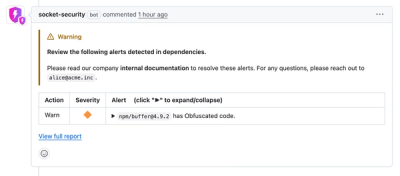
Security News
pnpm 10.16 Adds New Setting for Delayed Dependency Updates
pnpm's new minimumReleaseAge setting delays package updates to prevent supply chain attacks, with other tools like Taze and NCU following suit.
react-boxl
Advanced tools
Layout primitives for the styled component age.
$ npm i react-boxl styled-components
Built with styled components which is required as a peer dependency
Create components with the boxl function passing default props and styling.
// Examples.tsx
import * as React from "react";
import { boxl } from "boxl";
const Container = boxl({
spacing: "16px", // ⬅︎ adds spacing between children
style: `
background: white;
border: 8px solid black;
box-shadow: 12px -12px 0 0 black;
margin: 12px 12px 0 0;
padding: 24px;
`,
});
/**
* Additional props may be statically defined
* using an optional type parameter.
*/
interface SectionProps {
primary?: boolean;
}
const Section = boxl<SectionProps>({
style: styled => styled` // ⬅︎ tagged template literal à la styled-components
${props => (props.primary ? `background: black;` : ``)};
background: white;
border: 8px solid black;
padding: 32px;
`,
});

const Vertical = () => (
<Container>
<Section primary={true} />
<Section />
<Section />
</Container>
);

const Horizontal = () => (
<Container direction="horizontal">
<Section grow={1} primary={true} />
<Section />
<Section />
</Container>
);
alignHorizontal?: "left" | "center" | "right"
Aligns children horizontally regardless of direction (default: "left")
alignVertical?: "top" | "center" | "bottom"
Aligns children vertically regardless of direction (default: "top")
childGrow?: number
Sets grow on all children. Useful in combination with childWrap.
Example:
<Box childGrow={1}>
<Box>1</Box> // grow: 1
<Box>2</Box> // grow: 1
</Box>
childIdealWidth?: string (CSS length)
Sets idealWith on all children. Useful in combination with childWrap.
Example:
<Box childIdealWidth="20%">
<Box>1</Box> // idealWidth: 20%
<Box>2</Box> // idealWidth: 20%
</Box>
childWrap?: "auto" | "even"
Allows children to wrap when available space is exceeded
idealWidth or childIdealWidth which is useful for achieving an even grid layoutExample:
// Children wrap naturally
<Box
childGrow={1}
childWrap="auto"
direction="horizontal"
>
<Box>1</Box>
<Box>2</Box>
<Box>3</Box>
<Box>4</Box>
</Box>
// Children wrap evenly (orphans maintain idealWidth)
<Box
childGrow={1}
childIdealWidth="200px"
childWrap="even"
direction="horizontal"
>
<Box>1</Box>
<Box>2</Box>
<Box>3</Box>
<Box>4</Box>
</Box>
direction?: "horizontal" | "vertical"
Direction children will flow—stacked or side-by-side. (default "vertical")
Example:
// Children are stacked
<Box direction="vertical">
<Box>1</Box>
<Box>2</Box>
<Box>3</Box>
<Box>4</Box>
</Box>
// Children are side-by-side
<Box direction="horizontal">
<Box>1</Box>
<Box>2</Box>
<Box>3</Box>
<Box>4</Box>
</Box>
element?: string (HTML element—"a", "h1", etc.)
HTML element to be rendered (default "div")
Example:
// Anchor element will be rendered
<Box element="a" href="http://google.com">
Take me to google...
</Box>
grow?: number
Amount that Box should grow in relation to available space or siblings (default: 0)
Example:
<Parent>
<Box grow={1}>1</Box> // fills available space
<Box>2</Box>
<Box>3</Box>
</Parent>
idealWidth?: string (CSS length)
Optimal width considering content size and available space (i.e. flex-basis) (default: "left")
Note: Use alongside width or max/min-width styles
padding?: string (CSS length)
Adds padding and takes priority over padding set via style
spacing?: string (CSS length)
Defines gap between children
style?: string | template literal | (style) => style`tagged template literal`
Defines styling via plain string, template literal, or tagged template literal function. The last option allows interpolation of props including a theme if a styled-components theme provider is present.
Note: See styled components docs for more info
Example:
// string
<Box style="background: red; color: white;" />
// template literal
<Box
style={`
background: red;
color: white;
`}
/>
// tagged template literal function
<Box
style={style => style`
background: ${props => props.theme.color.primary};
color: white;
`}
/>
npm i install project and test app depsnpm start starts storybooknpm test:unit runs unit testsnpm test:visual runs visual tests (requires storybook to be running e.g. npm start)npm test:visual:watch runs visual tests in watch modenpm run build compiles dist/npm pack generates .tgz for local testingFAQs
Layout primitives for the styled component age.
We found that react-boxl demonstrated a not healthy version release cadence and project activity because the last version was released a year ago. It has 3 open source maintainers collaborating on the project.
Did you know?

Socket for GitHub automatically highlights issues in each pull request and monitors the health of all your open source dependencies. Discover the contents of your packages and block harmful activity before you install or update your dependencies.

Security News
pnpm's new minimumReleaseAge setting delays package updates to prevent supply chain attacks, with other tools like Taze and NCU following suit.

Security News
The Rust Security Response WG is warning of phishing emails from rustfoundation.dev targeting crates.io users.

Product
Socket now lets you customize pull request alert headers, helping security teams share clear guidance right in PRs to speed reviews and reduce back-and-forth.